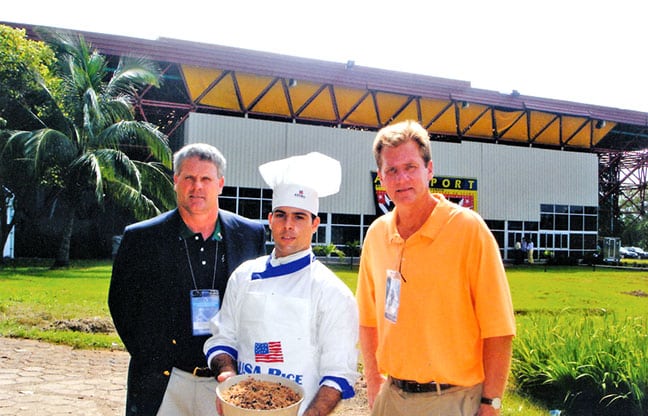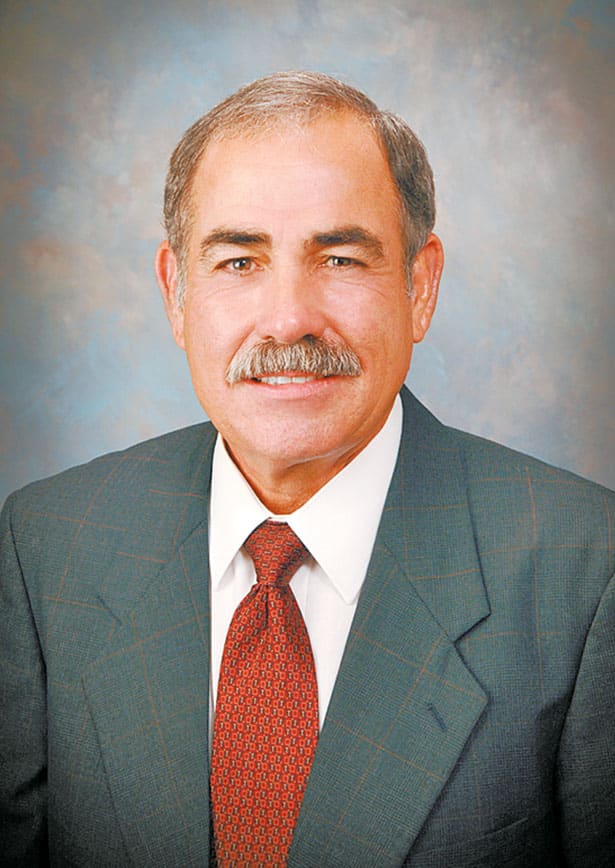“I’ve been working on this for 10 years. I’m very passionate about it.”
That’s Welsh rice farmer Brian Wild talking about the potential rice market in Cuba that became a bit more accessible recently when President Barack Obama declared “normalized” relations between Cuba and the U.S.
Wild went to Cuba in 2001. He was one of many in Southwest Louisiana who traveled to the island at about that time to pave the way for a resumption of rice trade between Cuba and Louisiana. On the visit, Wild met Castro’s brother Raul — the country’s nominal leader who, he says, was “already old” in 2001.
Of the potential for U.S. export of rice to Cuba that could develop in the wake of normalization, Wild says, “It would be tremendous.”
Randy Jemison, director of the Louisiana Field Services for the U.S. Rice Federation couldn’t agree more. “The U.S. rice industry is extremely excited,” says Jemison.
The sentiment is stated even more emphatically by Betsy Ward, president of USA Rice: “We know that the Cuban market is real; it’s large; it’s compelling.”
A Boon To Rural Farmers
Rural parishes in Southwest Louisiana depend on rice. Wild is a rice farmer in Welsh. Although he also grows some soybeans and crawfish, like most farmers in the area, rice is his go-to crop. “Most farms in Welsh rely on it,” he says.
A USL graduate, Wild is a third-generation rice farmer. “It’s in my blood … It’s a wonderful way to make a living.”
But it’s no secret that the Louisiana rice crop has struggled during much of the new century. In the latest downturn, prices have dropped 20 to 25 percent since 2011. It’s a slump that’s hurt the entire farming community. “All commodities are down,” says Wild.
Add to this lag in domestic rice prices the fact that the domestic market just isn’t big enough to meet the needs of the Louisiana rice farmer. “There’s only so much that can go to domestic use,” says Wild. “We have to export 60 percent of our crop.”
Making this situation even more difficult is the fact that as U.S. farmers, those who raise rice in Louisiana “must face tariffs without getting subsidies.” They must try to sell rice to powerful countries that aren’t devoted to free market economics and aren’t afraid to charge prohibitive tariffs to keep out foreign rice.
On top of all this, rice farmers in SWLA face still another economic challenge because of their location and climate, which are ideal for rice farming; not so great for other kinds of farming. Louisiana is made for rice farming. Its climate doesn’t allow it as many options in crop rotation as states that are a little further north. “We can’t switch to corn or soybeans,” says Wild.

Welsh rice farmer Brian Wild (far right) with Arkansas rice farmer Joe Mencer and a Cuban chef in Havana in 2003.
And Then There’s Cuba
Consider all these economic challenges and it won’t take you long to figure out why Louisiana rice farmers were so enthused about Obama’s recent moves to normalization with Cuba. It was a vivid reminder that the Louisiana rice farmer thrives on the cultivation of new markets to which Louisiana rice can be exported.
“We could increase our rice acres if we could open up markets,” says Wild. He and others always keep an eye far afield to scout out any groups who might be groomed for the importing of Louisiana rice. “We’re constantly trying to open up markets.”
“Mexico is now the No. 1 market” for rice exported from SWLA, says Wild. “We had to build it.” Mexicans, who are used to corn and fiercely devoted to it, had to be taught how to eat and cook Louisiana rice. They had to be persuaded that it could be a viable stand-in for corn.
Wild just finished going to China on a rice fact-finding trip. “We’re trying to get in that market.”
Another market that has recently been developed is that of Colombia, where the government was persuaded to sign a 10-year agreement to reduce tariffs. “That’s been tremendous,” says Wild.
And then there’s Cuba, where nobody has to be taught how to eat rice.
“Cuba would be tremendously [helpful], especially for the rural parishes [of Southwest Louisiana] and the Port of Lake Charles,” says Wild. “Cuba already likes rice and wants the long-grain rice we grow here. I know they will buy it.”
Politics
“Rice is the world’s largest food source, but it is also the most politically sensitive commodity,” says Wild. This fact has long stood in the way of the resurrection of the Cuba-U.S. rice trade that thrived until the late 1950s.
In the days before Castro took power, Cuba was a huge trader with Louisiana ports and rice growers. It was a “very lucrative market” for the Port of Lake Charles, says director Bill Rase. Then the Cuban Missile Crisis came along in 1962 and gave Americans the worst scare they’d had since Pearl Harbor.
The Cold War was raging as intensely as it ever had, and Americans thought — perhaps correctly — that it would be the easiest thing in the world for the Soviet Union to lob nuclear missiles into America from Cuba. An embargo on Cuba was a popular measure for 30 years.
But then the Cold War ended as the Soviet Union collapsed. In the 1990s, one of the things about the U.S. that most puzzled Europeans was the country’s apparent fear of Cuba. How, they wondered, could the world’s most powerful country be intimidated by a small, weak, poverty-stricken island? U.S. tourists often found themselves hard-pressed to explain the situation.
In 2009, in an article titled “The High Price of Hypocrisy,” Andy Hewes of the Coastal Rice on Cuba group, stated sentiment comparable to those of the puzzled Europeans; wrote Hewes, “There is no military threat from Cuba, no economic threat from Cuba, no political threat from Cuba, no social threat from Cuba — indeed, no threat at all from Cuba.”
“I understand Castro is not a nice guy,” says Wild. But it’s simply a fact that the era of Castro is a relic of the past.
Wild feels that any serious anti-American sentiment that might have thrived in Cuba during the Cold War has disappeared along with the war. “I’ve been there [to Cuba],” he says. “The people actually love the U.S. In Havana. The Capitol Building is actually a replica of the U.S. Capitol Building. They’re very friendly to the U.S. I don’t see where there’s a threat to the U.S.
“They want to interact and have the commerce.”
It’s true that politics has kept the embargo in place right up to the end of 2014. But it hasn’t been the politics of the Cold War; it’s been U.S. electoral politics that’s done the damage.
“It’s all Florida politics,” says Wild. “If you want to be president, you’ve got to win Florida.” Many presidential candidates are afraid of crossing members of the Cuban-American community in Florida who want the embargo to stay in place.
Many in Southwest Louisiana are working hard to argue for the ultimate advantage of sound, profitable trade over partisan politics. Representatives of the Port of Lake Charles will take a trip to Washington, D.C., in the spring to present the merits of the case for trade with Cuba.
“Yes, we have been talking to our representatives,” says Rase. “We spend a lot more time in Washington than people realize.”
Wild is going to Washington next month. “I will definitely be seeing Sen. Vitter. The more attention and pressure we can put on those [who oppose normalization], the better.”
“It’s time for [the embargo] to stop,” says Wild. “It’s not working. It’s hurting the common people in Cuba.”
What Could Happen?
Suppose the last lingering political prejudices against Cuba could be laid to rest? What do the ports and rice farmers of Louisiana stand to gain from free and open rice trade with Cuba?
Jemison says the average Cuban eats 180 pounds of rice a year — that’s 180 pounds times 11,000,000 people.
Castro, his brother Raul, or whoever is running Cuba, is still importing rice — plenty of rice. But it comes from Vietnam, where rice is dirt cheap. “Cubans don’t like it,” says Wild, because of its low quality and the resulting bland taste.
Jemison points out the obvious advantages over Vietnam that Louisiana enjoys from its proximity to Cuba. “We are so much closer [to Cuba] than Vietnam [is]. We’re in so much better position.”
Whatever rice Cuba can’t get from Vietnam, it gets from Brazil, which is still a good bit further away than the Port of Lake Charles.
Wild thinks Louisiana could realize as much as $2 billion from unrestricted rice trade with Cuba. If that $2 billion sounds a lot higher than other estimates you’ve heard (including the $150 million figure Agriculture Secretary Mike Strain just offered), keep in mind that lower estimates may just take into account the sums that result from the sale of rice alone. But, as Wild notes, rice sales always generate revenue for such things as fertilizer, fuel, shipping, trucking, elevators and mills.
According to Todd Henderson, director of operations at the Port of Lake Charles, even with all its problems, Cuba is nevertheless importing 550,000 metric tons of milled rice — rice that’s ready to put in the pot and cook — every year. With all its economic problems, Cuba still spends $300 million each year buying rice. Suppose it were in a position to spend more.
The Perfect Position
Rase says the Port of Lake Charles is in the very best position to export rice to Cuba. “Logistics will dictate how things go,” says Rase. “We’re positioned as well as anyone in the Gulf. The sailing time [to Cuba] isn’t different [from that from the Port of New Orleans].”
“Rice is accessible to our farmers. That makes Cuba a huge benefit.” SWLA rice farmers already grow the long-grained rice the Cubans like. A farmer in Welsh or Jennings just has to load his rice into a truck and drive it to the Port of Lake Charles. The process is immensely more cost-effective than trucking California rice to Lake Charles. “Whatever [rice] is going to come out of America ought to come out of Louisiana,” says Rase.
“We want the rice to come through here” — through the Port, says Rase. Of course, rice wouldn’t be the only U.S. commodity flowing to Cuba through American waterways. “The Mississippi River will be a player,” says Rase, “but more in other commodities [than rice].”
‘Normalization’ Is Not Free Trade
So … Louisiana rice farmers could breathe easier. Cubans could chow down on the long-grain rice they want. Sounds like a sweetheart deal. What’s holding it up?
Havana is a city that’s ready for the good times to return. Havana, says Wild, is a “beautiful place. It would be like New Orleans on a tropical island in the Caribbean.” But right now, he says, the city is “falling apart … Those people need some money.”
Jemison concurs. “The biggest problem [in Cuba] is they don’t have money.”
Readers should not assume that Obama’s new normalization eliminates all parts of the embargo. Far from it. Due to stipulations of the embargo that remain, U.S. rice growers “can’t extend credit” to Cuban buyers, says Jemison.
It’s not that Jemison won’t take what he can get. “There is some liberalization to the policy [of President Obama] … We take these changes very seriously. It’s a great first step.” But “what we really need is full and open commerce … We need that embargo lifted.”
He says that right now, 25 different food and agricultural organizations are working together to see that all parts of the embargo against Cuba are lifted. U.S. rice interests must be in a position to issue credit to Cuba so that the battered country can take the steps it needs to take to make it a player in the rice market once again.
The Port of Lake Charles is “in full support of the farmers and rice growers,” says Rase. Port staff are old hands at courting the Cubans. The Port sent two commissioners and staff to the island as rice trade with Cuba was renewed at the beginning of the century.
If all parts of the embargo are lifted, thinks Jemison, the Cubans will eventually be able to “generate money to buy rice.” If real free trade with Cuba were to come into being, the economic benefit to the Port of Lake Charles would, says Rase, be “almost immediate … We can move and store [the rice] today. But [given the economic realities of the present situation], we’re probably not going to budget for Cuban rice in the next couple of years.”
Many readers will remember that renewed rice trade with Cuba was already tried earlier this century. Louisiana rice — including much shipped from the Port of Lake Charles — was sold to Cuba from 2001-08; revenue from Cuba peaked at $64 million in 2004.
In 2009, President W. Bush’s Treasury Department passed new rules that put an effective end to rice trade with Cuba. One of the new rules required that Cuba pay in advance at a U.S. port for each purchase made.
In the 1990s, Jemison worked in Cuba to pave the way for the rice imports from the U.S. In the end, the groundwork wasn’t enough to overcome the economic challenges Cuba faced.
“I think we will see some rice get into Cuba [in the near future],” says Jemison. “We still need some changes. There’s lots of work ahead … We’ll be doing a full court press.”
Getting Up To Speed
Of course, for all the dreams of U.S. exporters to come true, Cuba will eventually have to do the hard work of moving into the global economy and paying the price for American commodities, equipment and consumer goods. When I proposed this scenario to Port of Lake Charles Director Bill Rase, he laughed and joked, “So we’re looking at 2050.”
“Cuba has been stuck in 1962 since 1962,” says Rase. For Cuba, modernization of trade would involve such economic factors as the condition of the road structure. “Are they going to need cars? Clothes?” asks Rase; or will Cubans be content to go on with the same low-cost, low-quality goods to which they’ve grown accustomed?
And it’s not just a question of finding the money for real American tee shirts and jeans. Cuba will, says Henderson, need such high-dollar items as modern “telecommunications, farm equipment.” The economy will have to be modernized from “top to bottom.”
“How do they overcome their economic situation?” asks Rase. “That’s going to be the real stumbling block on the Cuban side.
Of course, a big part of this revitalization process would have to be a rebuilding of the Havana tourism trade. In the mid 20th-century, Havana may have been the most lucrative tourist destination in the world. The Cubans will have to able and willing to bring back the irresistible flavor of Havana pre-Castro.
“It’s going to be a slow comeback … My perception is it’s going to take several years,” says Rase.
Like others in Southwest Louisiana, Rase feels that Obama’s Cuba proclamation was a good first step. But it was the first step of a very long journey. “The announcement is great, but what it is is an announcement … I think it’s going to take a little time.”



















Comments are closed.